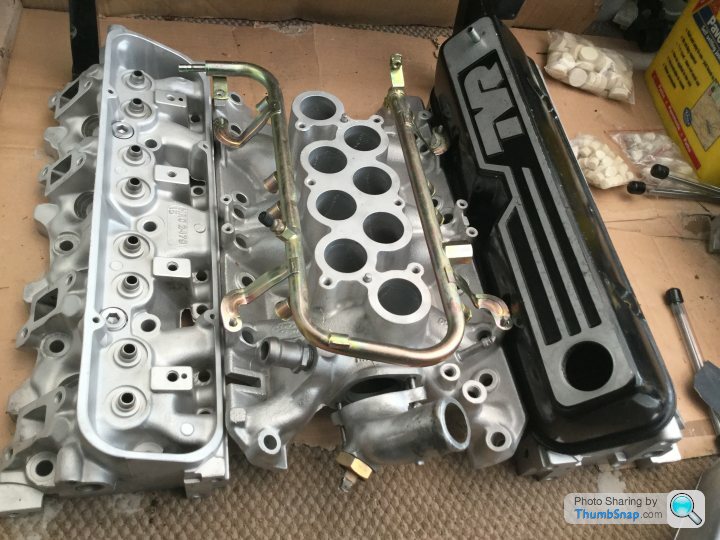45mm inlet and Plenum base inc 72 mm throttle pot.
Discussion
N7GTX said:
Keep up the good work there Divvy. Those head are like brand new. Are you trying to steal Mac's super shiny blingy crown? 

Haha,, 


There’s no chance of that is there he’s the undisputed king, I just follow his lead,,,, guitar

Guides seem really good as do valves/seats
The black baked on oil suggests low oil and or never changing the stuff as valve and plug colour suggested the vehicle they came off ran fine.
Here’s what the end product should look like which is the whole point of it

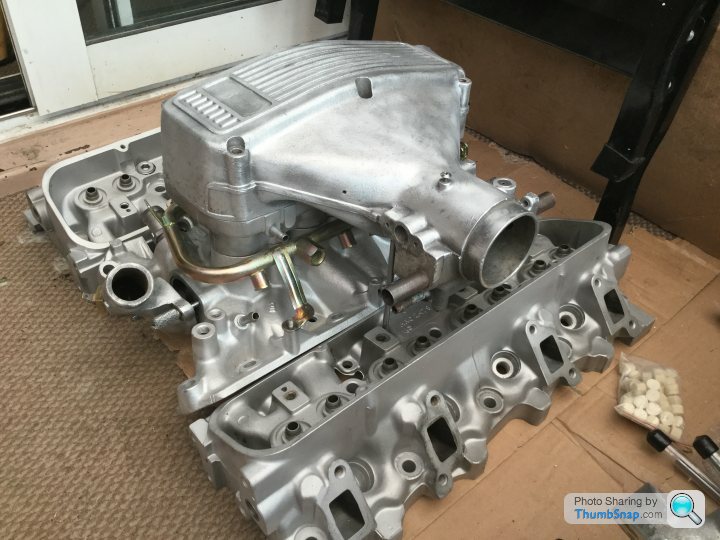
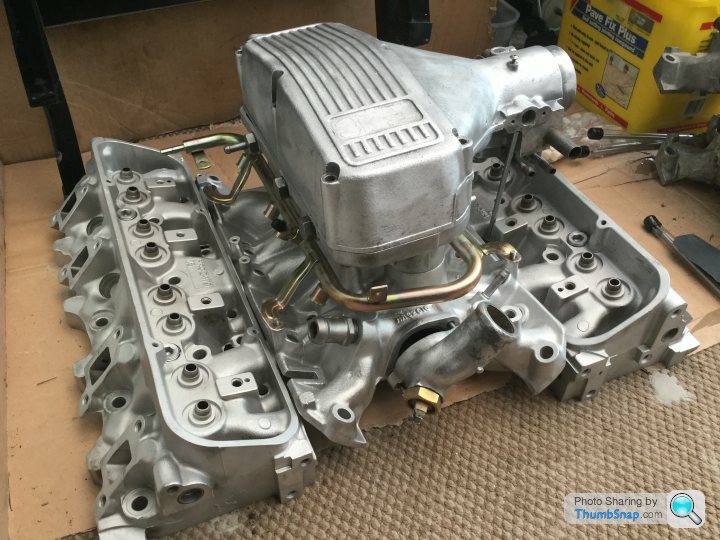
Edited by Classic Chim on Saturday 21st April 16:37
QBee said:
Or it means what it says and was made in 1597. I sometimes think the Rover V8 predates the industrial revolution by a couple of hundred years......bit like Yorkshiremen. 
What is it with you and Yorkshiremen 

Nah our engines are awesome if a bit restricted but I’m about to deal with that

QBee said:
I used to be fine with Yorkshiremen........then I bought a used car off one.
I like all Yorkshiremen that I have come across on PH and Faceache. Especially Jacko and Steve Edwards. Salt of the earth and all round good guys. And the SYTVRCC lot are good guys too.
It’s just the lying two-faced s tbag a
tbag a hole from Doncaster who sold me my Saab who has coloured my judgement regarding the inbabitants of God’s Own County.
hole from Doncaster who sold me my Saab who has coloured my judgement regarding the inbabitants of God’s Own County.
The twunt must have moved there! I like all Yorkshiremen that I have come across on PH and Faceache. Especially Jacko and Steve Edwards. Salt of the earth and all round good guys. And the SYTVRCC lot are good guys too.
It’s just the lying two-faced s
 tbag a
tbag a hole from Doncaster who sold me my Saab who has coloured my judgement regarding the inbabitants of God’s Own County.
hole from Doncaster who sold me my Saab who has coloured my judgement regarding the inbabitants of God’s Own County. Will do  Yep that’s what I thought.
Yep that’s what I thought.
So far I’ve lined up a gasket and ported the inlet manifold to the gasket but I can’t help but feel the tolerances in the bolt connecting holes is so big lining the manifold up to heads accurately after porting them will be a guess so I’m thinking of drilling some small holes in indiscriminate places that won’t effect gasket seal that goes through manifold/ gasket and a couple of mm into the heads, one st each end of both heads.
So when you bolt the heads to a car you can line up each side with the small holes in the heads and manifold and slowly nip down manifold on both sides You’ll be able to locate the gasket in exactly the correct position at the same time.
Years ago an old mechanic knew I had an interest in this porting lark and told me stories of his Bentley days
Drilling and putting a small dowl in place so you could line them and the exhausts up after they too had port matched the manifolds.
Trouble is I don’t think the tvr manifold will work with dowels but something similar has to be the order or it’s a waste of 60 hrs of my time if they don’t line up perfect every time
Eta the drilled holes and dowel trick might just work on the exhaust manifolds though.
I’ve been pondering this for awhile then remembered that old chap. Great bloke who re floored my old Jag many years ago. This bloke made floor pans that were like the original only better from sheets of tin
 Yep that’s what I thought.
Yep that’s what I thought. So far I’ve lined up a gasket and ported the inlet manifold to the gasket but I can’t help but feel the tolerances in the bolt connecting holes is so big lining the manifold up to heads accurately after porting them will be a guess so I’m thinking of drilling some small holes in indiscriminate places that won’t effect gasket seal that goes through manifold/ gasket and a couple of mm into the heads, one st each end of both heads.
So when you bolt the heads to a car you can line up each side with the small holes in the heads and manifold and slowly nip down manifold on both sides You’ll be able to locate the gasket in exactly the correct position at the same time.
Years ago an old mechanic knew I had an interest in this porting lark and told me stories of his Bentley days

Drilling and putting a small dowl in place so you could line them and the exhausts up after they too had port matched the manifolds.
Trouble is I don’t think the tvr manifold will work with dowels but something similar has to be the order or it’s a waste of 60 hrs of my time if they don’t line up perfect every time

Edited by Classic Chim on Sunday 22 April 00:10
Eta the drilled holes and dowel trick might just work on the exhaust manifolds though.
I’ve been pondering this for awhile then remembered that old chap. Great bloke who re floored my old Jag many years ago. This bloke made floor pans that were like the original only better from sheets of tin

Edited by Classic Chim on Sunday 22 April 00:15
Sardonicus said:
The doweled intake method is what I used on my fast Ford X Flow back in the 90's however no good for a V config, I indexed my inlet manifold on the RV8 to the heads with a fine tyre pen marking gasket to valley/block and both heads  your right quite a lot of movement and you need to keep an eye on your ref marks as the intake pulls down into the valley
your right quite a lot of movement and you need to keep an eye on your ref marks as the intake pulls down into the valley
It’s all very well just lining them up on a perfect centre but as you say will they bolt down like that when on the block. Heads might not even fit square for all I know. I’ll need a big set square to check them when putting it together,,, mad scientist comes to mind but if you ignore this it’s all a bit of a waste of time.  your right quite a lot of movement and you need to keep an eye on your ref marks as the intake pulls down into the valley
your right quite a lot of movement and you need to keep an eye on your ref marks as the intake pulls down into the valley I did think some marker pen would do the job and you’ll see any changes when you tighten them down. It’s the gasket I’m also trying to get spot on but the pen idea would work there too.
The Valley gasket is fairly rigid after all and won’t de form.
I just like the idea of a permanent solution and easy reference points.
At a rough guess something like this
The head has a raised platform for the manifold to sit on, I’m sure I can drill through the manifold and into the head a few mm for my reference marks.
It will go through the gasket too so all three matched for position in one go.
Ok I’m coming to a decision, tell me if it needs work
I port heads to gasket line. Bolt head and gasket to manifold. Use camera to check for steps And fine tune porting to match, repeat this process until it all lines up every time then finally drill my small pilot holes for future reference
Repeat on other side of manifold and 2nd head.
Hope it all lines up when on an engine!
Good or bad idea ?
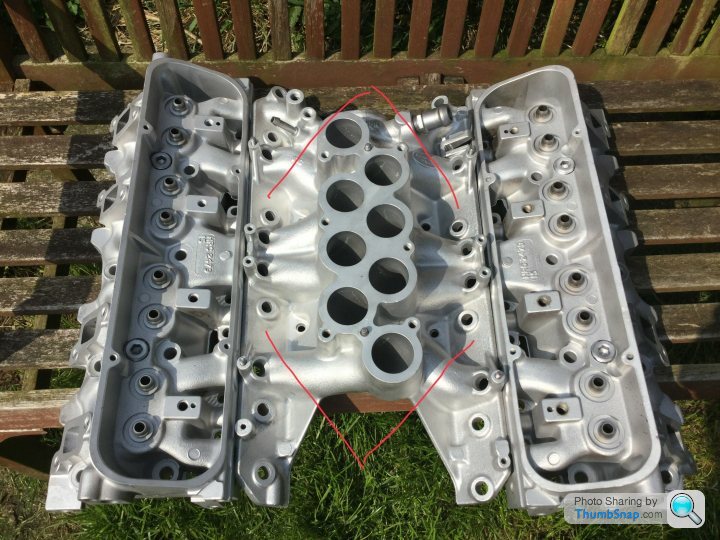
The head has a raised platform for the manifold to sit on, I’m sure I can drill through the manifold and into the head a few mm for my reference marks.
It will go through the gasket too so all three matched for position in one go.
Ok I’m coming to a decision, tell me if it needs work

I port heads to gasket line. Bolt head and gasket to manifold. Use camera to check for steps And fine tune porting to match, repeat this process until it all lines up every time then finally drill my small pilot holes for future reference
Repeat on other side of manifold and 2nd head.
Hope it all lines up when on an engine!
Good or bad idea ?

SuperApeInGoodShape said:
What valve sizes do you have?
Intermediate usually means Inlet at 41.4mm / 1.63" but those don't come as standard on any rover factory heads,
Stock rover sizes are;
Standard 39.83mm
Small 38mm (Rover P5 only IIRC)
Aftermarkets are;
Intermediate 41.4mm (limit of what will fit on a standard seat)
TVR Big Valve 43mm
44.4mm
46.8mm
You're starting from the wrong end, bowl work first.
The graph below shows head flow at 28" for a port match in red and in blue, removing the lip in the aluminium at the valve throat to seat insert and a quick blend in the same area. Both for a standard ERC0216 head with standard 39.83mm inlet valve. HRC2210's are nigh on identical ( maybe 1-2cfm flow advantage at a couple of lift points stock, and no advantage when ported)
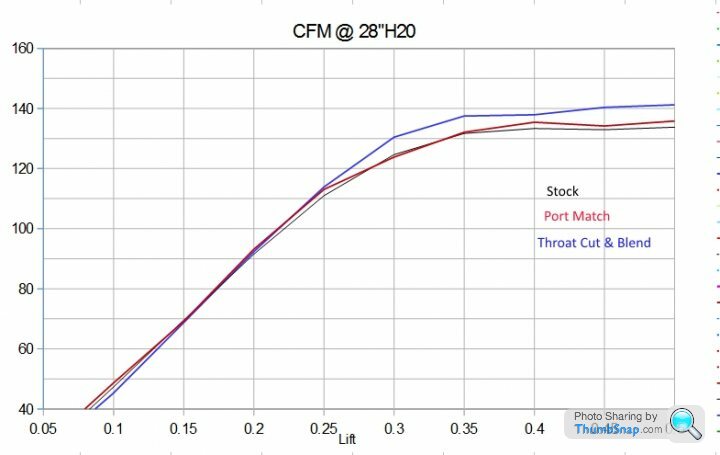
Thanks for your post. Intermediate usually means Inlet at 41.4mm / 1.63" but those don't come as standard on any rover factory heads,
Stock rover sizes are;
Standard 39.83mm
Small 38mm (Rover P5 only IIRC)
Aftermarkets are;
Intermediate 41.4mm (limit of what will fit on a standard seat)
TVR Big Valve 43mm
44.4mm
46.8mm
You're starting from the wrong end, bowl work first.
The graph below shows head flow at 28" for a port match in red and in blue, removing the lip in the aluminium at the valve throat to seat insert and a quick blend in the same area. Both for a standard ERC0216 head with standard 39.83mm inlet valve. HRC2210's are nigh on identical ( maybe 1-2cfm flow advantage at a couple of lift points stock, and no advantage when ported)

Edited by SuperApeInGoodShape on Sunday 22 April 10:52
I haven’t actually started on the heads.
I’m mainly concentrating on roof porting for exhaust ports and matching to inlet.
Yes to both points re throat porting and seat area as there are some serious steps in that area.
These are the standard 39.8 mm valves and the seats look very good but I havnt decided on valve size yet so no point touching that area until I decide. Be easier to dress up without seats there for a start so I’m thinking big as I can get really.
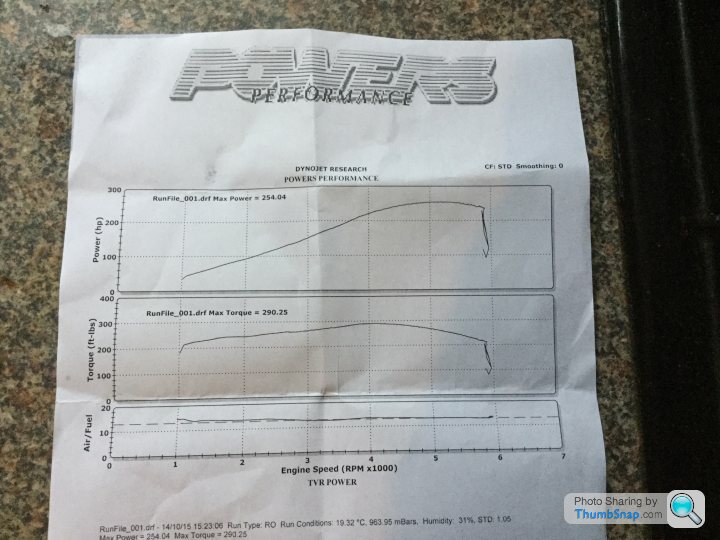
Engine has been rebuilt but with standard heads and exactly the same as the ones I’ve pictured here other than steel rockers and double valve springs, 5 years +
4.6 engine with main cat in place. You can add 5-10 hp straight away by removing Cat.
My long term plan is to prove these heads and manifold on my car on a dyno while I then rebuild/port my own heads to similar spec incl inlet manifold then sell them as a matched set to pay off my friends

If I can show what they can do hopefully someone will want them

These heads the ports overall are very impressive if small.
I was told the later cast ones are good and I’d fully agree.
There’s very little room around the throat area and some of that needs to support the seat.
Looks to me like biggest valves are the only real solution and no amount of burr grinding can change that fact.
I’d really like to look at Tvr 5.0 heads but also a Boggo 4.0 head off an earlier engine to see if these castings are indeed better or not. The port shape etc
Edited by Classic Chim on Sunday 22 April 18:07
The graph is at the wheels so adding a rather generous 15/17% road train loss and if you also add the known quantity of a Clive Y piece at around 7/10 hp I can easily make it add up to 300 but thats just games 
I have used a Clive Y and my car was faster by over 1/2 second on the drag strip.
That’s interesting math on what can be gained. I thought I’d have more to do on these heads but it’s really just tickling them mostly. Shortened guides look to be a must going by the little space available around them.
Steep learning curve and I’ve only just got the heads so I’ll be taking my time and learning off a master or two hopefully.
Without that knowledge I wouldn’t touch these heads as the ports look good to me and as your graph earlier shows very little will be gained unless the valve and throat area is shaped.
I was hoping to use original seats but the bigger the valve the more I can smooth the steps out.
On my own car I’d possibly risk using the guides which are like new and just shortening them but it’s false economy and just a worry factor so if new big valves are going in then billet guides on the list.
I better start earning some money I know that.
Great fun though as I know a RR head better then I thought I would already and I’ve only had them a week.

I have used a Clive Y and my car was faster by over 1/2 second on the drag strip.
That’s interesting math on what can be gained. I thought I’d have more to do on these heads but it’s really just tickling them mostly. Shortened guides look to be a must going by the little space available around them.
Steep learning curve and I’ve only just got the heads so I’ll be taking my time and learning off a master or two hopefully.
Without that knowledge I wouldn’t touch these heads as the ports look good to me and as your graph earlier shows very little will be gained unless the valve and throat area is shaped.
I was hoping to use original seats but the bigger the valve the more I can smooth the steps out.
On my own car I’d possibly risk using the guides which are like new and just shortening them but it’s false economy and just a worry factor so if new big valves are going in then billet guides on the list.
I better start earning some money I know that.
Great fun though as I know a RR head better then I thought I would already and I’ve only had them a week.

I’ve been studying air flow on a basic level for some time now and flow upto and around a valve is very interesting indeed. How the characteristics of the incoming air and fuel change as piston goes down the stroke. High pressure then lower but sucked in more and how it swaps from roof to floor port pick up of the air as it does so.
The fact the runners are tubular going into rectangles just before the heads doesn’t help much.
Hahah, it’s often the opposite wall to the one you think is to be worked but watching plenty of videos of liquid and air through pipes has helped a lot to understand how the air acts in motion and then when it hits a bend.
I noticed how the inlet manifold does have a dish shape on the opposite wall after a corner, air hits it and the dish shaping in the casting chucks it back towards the middle of the port.
The fact the runners are tubular going into rectangles just before the heads doesn’t help much.
Hahah, it’s often the opposite wall to the one you think is to be worked but watching plenty of videos of liquid and air through pipes has helped a lot to understand how the air acts in motion and then when it hits a bend.
I noticed how the inlet manifold does have a dish shape on the opposite wall after a corner, air hits it and the dish shaping in the casting chucks it back towards the middle of the port.
Edited by Classic Chim on Sunday 22 April 19:07
SuperApeInGoodShape, that’s funny enough 
You sound like you’ve done plenty of this work so I Thankyou for your contributions to this thread.
Inlet continuity does worry me a touch but going to 44/45 mm it’s hitting a restriction when it hits the heads rather than before them.
I’m starting to think more about velocity than outright size and keeping a constant flow vital for that end goal.
I have a 5.0 inlet I borrowed here as standard Tvr and it tapers so that's becoming my preferred option but need sizing equipment to do this accurately on my own one.

You sound like you’ve done plenty of this work so I Thankyou for your contributions to this thread.
Inlet continuity does worry me a touch but going to 44/45 mm it’s hitting a restriction when it hits the heads rather than before them.
I’m starting to think more about velocity than outright size and keeping a constant flow vital for that end goal.
I have a 5.0 inlet I borrowed here as standard Tvr and it tapers so that's becoming my preferred option but need sizing equipment to do this accurately on my own one.
The only thing I can say about engine power speculation is go to the drag strip.
Dyno are one thing. The clock something very different and very accurate.
So I did
I raced a Suburu Imprezza with very similar levels of power, he said it was 300 hp and it was only a year old, we were neck and neck.
I did 12.60 1/4 mile on drag radials that rubbed on my arches I did 12.7 on Rainsport road tyres.
I don’t think I’d do the time without the power.
I’ve also raced a great racer and all round top dog in his Chim dyno’d at a different place to mine 325 Bhp and he usually just beats me so if I didn’t have that figure I’d be nowhere near him.
My block is decked and compression marginally higher and use aftermarket Ecu in MBE so get best use of advancing ignition etc.
If the figures are correct or not the times are
Who really knows with these bloody dyno.
Dyno are one thing. The clock something very different and very accurate.
So I did

I raced a Suburu Imprezza with very similar levels of power, he said it was 300 hp and it was only a year old, we were neck and neck.
I did 12.60 1/4 mile on drag radials that rubbed on my arches I did 12.7 on Rainsport road tyres.
I don’t think I’d do the time without the power.
I’ve also raced a great racer and all round top dog in his Chim dyno’d at a different place to mine 325 Bhp and he usually just beats me so if I didn’t have that figure I’d be nowhere near him.
My block is decked and compression marginally higher and use aftermarket Ecu in MBE so get best use of advancing ignition etc.
If the figures are correct or not the times are

Who really knows with these bloody dyno.
QBee said:
Yes, but are your heads, on your car at present, Range Rover or TVR spec, Alun?
I’m trying to avoid the question as I don’t know. As far as I know they are standard Rover heads from late 99 as that’s what I traced the engine date to. The cars march 2000 so that makes sense.
Dom was busy on bigger projects by that date and the Rover engine a thing of the past so as I’m aware no porting just bigger cam got installed.
But he’s a canny lad who keeps his cards close to his chest so unless he can remember what he did I’ll not know until there off the car.
Or he might level with me and tell me to stop wasting my time with these heads but it’s a standard 38 mm 4.6 Rover set up on Standard but very late heads with stock valves as far as I’m aware.
It might seem perverse to some but building a set of heads and getting fully involved in doing it good fun to me.
I want to machine the buggers too

I have a constant battle going on in my head
Leave my car alone or have Dom put the heads on because I like the continuity
Leave my car alone and simply sell these heads to someone who will want the extra power more than I do and sort out Peter.
Put them on and never look back!
If things go as I’d like
I’ll afford to do it all properly and prove there worth on my car on Dom’s rolling road then a real one with a clock.
At that point decide if I want my own to be done or leave them well alone as I do have a a very good car and engine right now that’s fantastically usuable and that’s very important.
Jason has said he can get it to run just as good with the bigger stuff on there so not to worry about it but I might ask him again to be sure.
I nearly bought a model aeroplane last year,, spend more on them than on these heads just crashing every week

Aaaaaarrrhh, what an education can do for you 
Saying that I grew up in the Midlands in a fairly well to do household then pop off to Wales to see my family and mates who had 2p to their name yet all had horses or many of them did stabled on the farm, all wild ponies they caught for free.
Nearly all gone now on those hills hear my nans place but those boys I used to be envious of and they could really ride,,,bare back, hard to believe now but the bloody things ran up and down the streets, well there was hardly any cars there even in the 70’s
They all look happy there mate
By the way their talking about you

Saying that I grew up in the Midlands in a fairly well to do household then pop off to Wales to see my family and mates who had 2p to their name yet all had horses or many of them did stabled on the farm, all wild ponies they caught for free.
Nearly all gone now on those hills hear my nans place but those boys I used to be envious of and they could really ride,,,bare back, hard to believe now but the bloody things ran up and down the streets, well there was hardly any cars there even in the 70’s

They all look happy there mate

By the way their talking about you

SuperApeInGoodShape said:
Alun if you've still got your timing slip from your 1/4 mile sessions you can probably guesstimate if its crank or wheel hp from your 1/4 terminal mph figure.
If a chim really is 2500 - 2550 lbs you'd expect somewhere around 108mph for 254bhp flywheel or 113mph for 300bhp flywheel.
Very interesting as I’m usually about 110 mph and 108 on my fastest run that was going to be 112 or so based on my 60ft time but I was getting drag. Hot day too. If a chim really is 2500 - 2550 lbs you'd expect somewhere around 108mph for 254bhp flywheel or 113mph for 300bhp flywheel.
I’ve often thought it’s probably about 285/290 at the fly based on driving other Tvr that have been Dyno tested. I was told it was the second highest figures they’d got for that spec engine.
I think the Dyno at Powers is not that far off.
Edited by Classic Chim on Monday 23 April 14:16
Gassing Station | Chimaera | Top of Page | What's New | My Stuff




